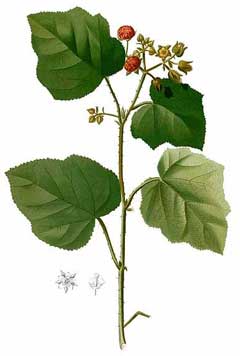 |
|
http://commons.wikimedia.org/wiki/File:Rubus_moluccanus_Blanco2.393-cropped.jpg |
 |
|
Translate this page:
Summary
Physical Characteristics

 Rubus moluccanus is a deciduous Shrub growing to 6 m (19ft) by 6 m (19ft). The species is hermaphrodite (has both male and female organs) and is pollinated by Insects.
Rubus moluccanus is a deciduous Shrub growing to 6 m (19ft) by 6 m (19ft). The species is hermaphrodite (has both male and female organs) and is pollinated by Insects.
Suitable for: light (sandy), medium (loamy) and heavy (clay) soils and prefers well-drained soil. Suitable pH: mildly acid, neutral and basic (mildly alkaline) soils. It can grow in semi-shade (light woodland) or no shade. It prefers moist soil.
UK Hardiness Map
US Hardiness Map
Synonyms
Plant Habitats
Woodland Garden Sunny Edge;
Edible Uses
Edible Parts: Fruit
Edible Uses:
Fruit - raw or cooked and used in pies, preserves etc[146, 177, 183]. It has a sour flavour and is astringent[193].
References More on Edible Uses
Medicinal Uses
Plants For A Future can not take any responsibility for any adverse effects from the use of plants. Always seek advice from a professional before using a plant medicinally.
Abortifacient Astringent Emmenagogue Enuresis
The leaves are abortifacient, astringent and emmenagogue[240
, 360
]. The leaves, or the sap they contain, can be used to treat dysentery[310
]. The sap from young shoots is drunk in a single dose to induce labour[310
]. A decoction of the tender leaves, combined with the leaves of Psidium guajava, Perilla ocimoides and Vernonia volkameriaefolia plus the root of Urena lobota root, is used to treat abdominal pain[360
].
The leaves are chewed with salt and then spat onto sores to promote healing[310
]
Sap from the leaves or stems is used to treat eye diseases[310
].
The fruit is considered to be a useful remedy for the nocturnal micturition of children (bed-wetting)[240
, 360
].
The roots are astringent and a blood tonic[310
, 360
]. A decoction of the roots is used in the treatment of dysentery and other internal complaints[310
].
The bark contains around 10% tannins and is an effective astringent[360
].
References More on Medicinal Uses
The Bookshop: Edible Plant Books
Our Latest books on Perennial Plants For Food Forests and Permaculture Gardens in paperback or digital formats.

Edible Tropical Plants
Food Forest Plants for Hotter Conditions: 250+ Plants For Tropical Food Forests & Permaculture Gardens.
More

Edible Temperate Plants
Plants for Your Food Forest: 500 Plants for Temperate Food Forests & Permaculture Gardens.
More

More Books
PFAF have eight books available in paperback and digital formats. Browse the shop for more information.
Shop Now
Other Uses
Dye
A purple to dull blue dye is obtained from the fruit[168].
Special Uses
References More on Other Uses
Cultivation details
Rubus moluccanus has a wide native range from the Himalayas through tropical southeast Asia to eastern Australia, where it can be found as far south as the warm temperate zone of Victoria. In the temperate zone, it can only be grown in regions with mild winters.
Easily grown in a good well-drained, loamy soil in sun or semi-shade[1
, 11
, 200
].
The plant spreads by means of bird-sown seeds and vegetatively to form thickets. It has escaped from cultivation and become a weed in several areas, including the Mascarene Islands and southeastern N. America[413
].
There is at least one named variety occasionally cultivated for its edible fruit. 'Keri' (or Keriberry) is a very vigorous plant with mild-flavoured large black fruits that lack the distinctive flavour of blackberries[183
].
Plants in this genus are notably susceptible to honey fungus[200
].
References Carbon Farming Information and Carbon Sequestration Information
Temperature Converter
Type a value in the Celsius field to convert the value to Fahrenheit:
Fahrenheit:
The PFAF Bookshop
Plants For A Future have a number of books available in paperback and digital form. Book titles include Edible Plants, Edible Perennials, Edible Trees,Edible Shrubs, Woodland Gardening, and Temperate Food Forest Plants. Our new book is Food Forest Plants For Hotter Conditions (Tropical and Sub-Tropical).
Shop Now
Plant Propagation
Seed - requires stratification and is best sown in early autumn in a cold frame. Stored seed requires one month stratification at about 3°c and is best sown as early as possible in the year. Prick out the seedlings when they are large enough to handle and grow on in a cold frame. Plant them out into their permanent positions in late spring of the following year. Cuttings of half-ripe wood, July/August in a frame[200]. Tip layering in July. Plant out in autumn. Division in early spring or just before leaf-fall in the autumn[200].
Other Names
If available other names are mentioned here
Native Range
TROPICAL ASIA: Sri Lanka, Papua New Guinea, Solomon Islands, India (Andaman and Nicobar Islands (Nicobar Island)), Laos, Myanmar, Thailand, Vietnam, Indonesia, Malaysia, Philippines PACIFIC: New Caledonia AUSTRALASIA: Australia (New South Wales (east), Queensland (east & north), Victoria (east))
Weed Potential
Right plant wrong place. We are currently updating this section.
Please note that a plant may be invasive in one area but may not in your area so it's worth checking.
Conservation Status
IUCN Red List of Threatened Plants Status :

Growth: S = slow M = medium F = fast. Soil: L = light (sandy) M = medium H = heavy (clay). pH: A = acid N = neutral B = basic (alkaline). Shade: F = full shade S = semi-shade N = no shade. Moisture: D = dry M = Moist We = wet Wa = water.
Now available:
Food Forest Plants for Mediterranean Conditions
350+ Perennial Plants For Mediterranean and Drier Food Forests and Permaculture Gardens.
[Paperback and eBook]
This is the third in Plants For A Future's series of plant guides for food forests tailored to
specific climate zones. Following volumes on temperate and tropical ecosystems, this book focuses
on species suited to Mediterranean conditions—regions with hot, dry summers and cool, wet winters,
often facing the added challenge of climate change.
Read More
Expert comment
Author
L.
Botanical References
Links / References
For a list of references used on this page please go here
Readers comment
© 2010, Plants For A Future. Plants For A Future is a charitable company limited by guarantee, registered in England and Wales. Charity No. 1057719, Company No. 3204567.